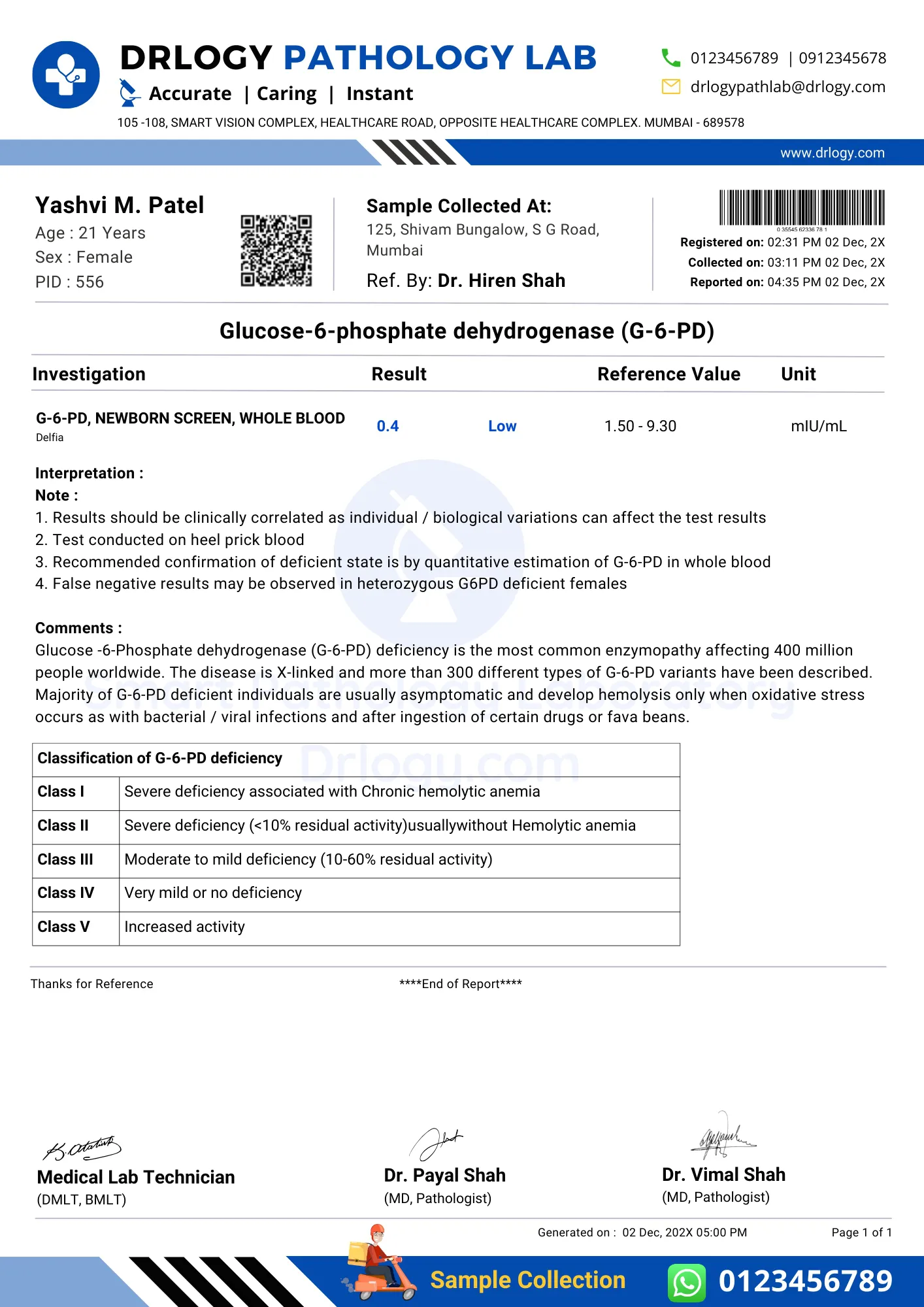
A G6PD test checks the level of a special enzyme in your blood, helping doctors diagnose a genetic condition that can make some people's red blood cells break down when they eat certain foods or take specific medications.
Here are the basic details of the G6PD Test.
| Also Known As | G6PD Enzyme Test |
| Type | Blood Test |
| Purpose | To diagnose G6PD deficiency, a genetic blood disorder. |
| Sample Type | Blood |
| Preparation | No |
| Fasting | No |
| Gender | Unisex |
| Age Group | All |
| Normal Value | 1.50 - 9.30 mIU/mL |
| Reporting Time | Few Days |
| Cost | 500-1000 INR* |
*Price range may vary as per location, lab type, and procedure of lab test.
G6PD Test measures glucose-6-phosphate dehydrogenase enzyme levels in blood.
The purpose of the G6PD Test is to:

Here is the basic preparation for the G6PD Test.
Here is the basic G6PD Test Procedure.


G6PD Normal Test Report PDF Format

G6PD Abnormal Test Report PDF Format
Here is the normal range of the G6PD Test.
| G6PD Test | Normal Value |
|---|---|
| G6PD | 1.50 - 9.30 mIU/mL |
Here is the Interpretation of the G6PD Test.
| G6PD Test Result | Interpretation |
|---|---|
| Normal | G6PD levels fall within the typical range (8.8-13.4 U/gHb). |
| Low | G6PD deficiency may be present, increasing risk of hemolysis. |
| Abnormal | Further evaluation needed to determine the severity and management. |
A G6PD test measures enzyme levels, with low levels indicating possible deficiency.
Here are some possible causes of high G6PD levels.
| Possible Causes | Effect |
|---|---|
| Hemolysis | Increased risk of red blood cell breakdown. |
| Infection | Inflammatory response to infections. |
| Medications | Some drugs can lead to elevated G6PD levels. |
| Chronic conditions | Certain medical conditions may affect G6PD levels. |
Elevated G6PD levels can result from hemolysis, infections, medications, or underlying medical conditions.
Here are some possible causes of low G6PD levels.
| Possible Causes | Effect |
|---|---|
| G6PD Deficiency | Genetic disorder leading to enzyme deficiency. |
| Hemolysis | Increased vulnerability to red cell breakdown. |
| Medications | Certain drugs can lower G6PD enzyme levels. |
| Infections | Illnesses can trigger low G6PD levels. |
Low G6PD levels indicate deficiency, potentially causing hemolysis, often due to genetic factors, medications, or infections.
Here are the specimen requirements for the G6PD Test.
|
Specimen |
Whole Blood |
|
|
Volume |
1 ml |
|
|
Container |
Red-top tube or gel-barrier tube |
|
|
Collection |
Separate serum from cells within one hour of collection. Transfer to a plastic transport tube before shipping. |
|
|
Storage |
Refrigerate or freeze. |
|
|
Sample Stability |
Temperature |
Period |
|
Room temperature |
7 days |
|
|
Refrigerated |
14 days |
|
|
Frozen |
60 days |
|
|
Freeze/thaw cycles |
Stable x1 |
|
|
Causes for Rejection |
Grossly hemolyzed; bacterial contamination; lipemic specimen; icteric specimen; non-serum specimen types |
|
This is generally safe with minimal risks.
Here is the basic limitation of G6PD Test.
Here are some of the risk factors of the G6PD Test.
Here are the Doctor's recommendations or consult a specialist after the G6PD Test.
| G6PD Test Result | Doctor to Visit | Reason |
|---|---|---|
| High | Hematologist | Possible underlying conditions or medication effects. |
| Normal | Primary Care Doctor | Routine follow-up for general health and monitoring. |
| Low | Hematologist | G6PD deficiency management and prevention of issues. |
After a G6PD test, consult a hematologist for high or low results and a primary care doctor for normal results.
Here are the estimated G6PD Test Prices in India with different top cities:
|
City |
Price Range (INR)* |
|
500-1000 |
|
|
550-1000 |
|
|
500-1000 |
|
|
550-1000 |
|
|
500-1000 |
|
|
550-1000 |
|
|
500-1000 |
|
|
550-1000 |
|
|
550-1000 |
|
|
500-1000 |
|
|
550-1000 |
|
|
500-1000 |
|
|
550-1000 |
|
|
500-1000 |
*Prices are approximate and vary depending on a specific laboratory or healthcare facility.
Summary
Overall, For G6PD test results, consult a hematologist for high or low levels and a primary care doctor for normal levels to guide your healthcare. Also check Drlogy Test for detailed information about all medical tests for patients, doctors, scholers and medical students.
Reference
DOCTOR'S MOST TRUSTED HEALTHCARE PLATFORM
10M+
Patients
30000+
Doctors
25000+
Hospitals/Labs